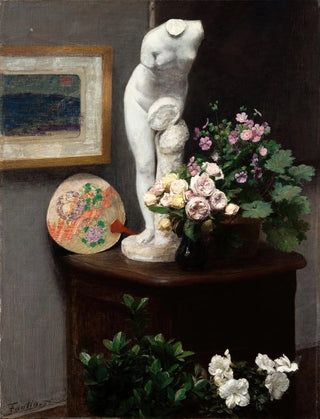Art print | Still life with torso and flowers - Henri Fantin-Latour


View from behind

Frame (optional)
Introduction captivante
The still life, often perceived as a mere exercise in style, transforms here into a true ode to beauty and human sensitivity. The artwork "Still Life with Torso and Flowers" by Henri Fantin-Latour fits within this tradition while transcending its conventions. In this painting, the viewer is invited to contemplate a dialogue between the fragility of the flowers and the robustness of a sculptural torso, a contrast that evokes both the ephemeral beauty of life and the permanence of art. This piece is much more than a simple representation; it is an invitation to escape, a suspended moment where time seems to stand still.
Style and uniqueness of the work
Henri Fantin-Latour's style is characterized by meticulous attention to detail and a palette of delicate colors. In "Still Life with Torso and Flowers," each petal, each curve of the torso is rendered with precision that demonstrates the artist's technical mastery. The flowers, bursting with life, contrast with the cold material of marble, creating a visual and emotional tension. Fantin-Latour plays with light, making it dance across surfaces, revealing textures that seem almost tangible. This work is a perfect example of his unique approach, blending realism and poetry, where each element tells a story and contributes to the overall harmony of the composition.
The artist and his influence
Henri Fantin-Latour, an emblematic figure of the 19th century, is recognized for his talents as a painter and lithographer. His work fits within the Impressionist movement, although he often preferred to explore more classical themes, notably still life and portraits. Fantin-Latour managed to establish himself in the art world thanks to his ability to capture the essence of his subjects, whether flowers, fruits, or human figures. His influence is palpable among many contemporary and later artists, who have been inspired by his delicate approach and respect for natural beauty. By integrating elements of classical tradition into a modern framework, Fantin-Latour paved the way for a new understanding of still life, transforming it

Matte finish

View from behind

Frame (optional)
Introduction captivante
The still life, often perceived as a mere exercise in style, transforms here into a true ode to beauty and human sensitivity. The artwork "Still Life with Torso and Flowers" by Henri Fantin-Latour fits within this tradition while transcending its conventions. In this painting, the viewer is invited to contemplate a dialogue between the fragility of the flowers and the robustness of a sculptural torso, a contrast that evokes both the ephemeral beauty of life and the permanence of art. This piece is much more than a simple representation; it is an invitation to escape, a suspended moment where time seems to stand still.
Style and uniqueness of the work
Henri Fantin-Latour's style is characterized by meticulous attention to detail and a palette of delicate colors. In "Still Life with Torso and Flowers," each petal, each curve of the torso is rendered with precision that demonstrates the artist's technical mastery. The flowers, bursting with life, contrast with the cold material of marble, creating a visual and emotional tension. Fantin-Latour plays with light, making it dance across surfaces, revealing textures that seem almost tangible. This work is a perfect example of his unique approach, blending realism and poetry, where each element tells a story and contributes to the overall harmony of the composition.
The artist and his influence
Henri Fantin-Latour, an emblematic figure of the 19th century, is recognized for his talents as a painter and lithographer. His work fits within the Impressionist movement, although he often preferred to explore more classical themes, notably still life and portraits. Fantin-Latour managed to establish himself in the art world thanks to his ability to capture the essence of his subjects, whether flowers, fruits, or human figures. His influence is palpable among many contemporary and later artists, who have been inspired by his delicate approach and respect for natural beauty. By integrating elements of classical tradition into a modern framework, Fantin-Latour paved the way for a new understanding of still life, transforming it






